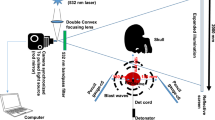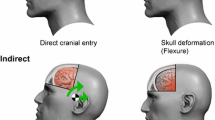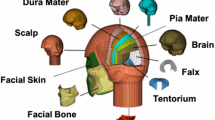Abstract
Mild traumatic brain injury (mTBI) resulting from the exposure to a blast shock wave is a challenging problem due to the broad long-term neurological deficits on the victims. The blast-related injury is not only due to the prevalence of military conflicts, but also due to increase terrorist attacks and domestic/industrial accidents. Mechanisms of blast-induced mild traumatic brain injury (BImTBI) have been controversial for a long time and nowadays are one of the most attentive topics among the neurotrauma researches. A physical head and neck model (PHNM) equipped with a surrogate gel brain was developed, and its dynamic responses to a blast wave were evaluated using a predesigned compressed air-driven shock tube. The neck model was constructed and tuned to simulate the actual human neck stiffness. The history of intracranial pressure (ICP) at different locations within the brain was monitored with four miniature pressure transducers. The acceleration of the head as well as the brain model was recorded using two accelerometers mounted internally and outside the PHNM. The shockwave effects on the PHNM were examined at different distance orientations from shock tube exit. The PHNM was exposed to free-field blast tests with controlled reliable positive peak pressure (PPP). The ICP amplitudes/profiles and the acceleration results vary according to the PHNM locations and orientations with respect to shock tube exit. The most vital parameters of ICP wave profiles including PPP, positive phase duration, and positive impulse values were greatly affected by the PHNM locations/orientations from the shock tube exit.
Similar content being viewed by others
References
Effgen G.B., Hue C.D., Vogel E. III et al.: A multiscale approach to blast neurotrauma modeling: part II: methodology for inducing blast injury to in vitro models. Front. Neurol. 3, 23–23 (2012)
Malojcic B., Mubrin Z., Coric B. et al.: Consequences of mild traumatic brain injury on information processing assessed with attention and short-term memory tasks. J. Neurotrauma 25(1), 30–37 (2008)
Trudeau D.L., Anderson J., Hansen L.M. et al.: Findings of mild traumatic brain injury in combat veterans with PTSD and a history of blast concussion. J. Neuropsychiatry Clin. Neurosci. 10(3), 308–313 (1998)
Thompson J.M., Scott K.C., Dubinsky L.: Battlefield brain Unexplained symptoms and blast-related mild traumatic brain injury. Can. Fam. Phys. 54(11), 1549–1551 (2008)
Sundaramurthy A., Alai A., Ganpule S. et al.: Blast-induced biomechanical loading of the rat: an experimental and anatomically accurate computational blast injury model. J. Neurotrauma 29(13), 2352 (2012)
Cernak I., Savic V.J., Lazarov A. et al.: Neuroendocrine responses following graded traumatic brain injury in male adults. Brain Injury 13(12), 1005–1015 (1999)
Chafi M.S., Karami G., Ziejewski M.: Biomechanical assessment of brain dynamic responses due to blast pressure waves. Ann. Biomed. Eng. 38(2), 490–504 (2010)
Garman R.H., Jenkins L.W., Switzer R.C. III et al.: Blast exposure in rats with body shielding is characterized primarily by diffuse axonal injury. J. Neurotrauma 28(6), 947–959 (2011)
Gieron M.A., Korthals J.K., Riggs C.D.: Diffuse axonal injury without direct head trauma and with delayed onset of coma. Pediatr. Neurol. 19(5), 382–384 (1998)
Courtney A.C., Courtney M.W.: A thoracic mechanism of mild traumatic brain injury due to blast pressure waves. Med. Hypotheses 72(1), 76–83 (2009)
Cernak I., Savic J., Malicevic Z. et al.: Involvement of the central nervous system in the general response to pulmonary blast injury. J. Trauma-Injury Infect. Crit. Care 40(3), S100–S104 (1996)
Chavko M., Watanabe T., Adeeb S. et al.: Relationship between orientation to a blast and pressure wave propagation inside the rat brain. J. Neurosci. Methods 195(1), 61–66 (2011)
Moss W.C., King M.J., Blackman E.G.: Skull flexure from blast waves: a mechanism for brain injury with implications for helmet design. Phys. Rev. Lett. 103(10), 4 (2009)
Kocsis J.D., Tessler A.: Pathology of blast-related brain injury. J. Rehabil. Res. Dev. 46(6), 667–671 (2009)
Chen Y., Huang W., Constantini S.: Concepts and strategies for clinical management of blast-induced traumatic brain injury and posttraumatic stress disorder. J. Neuropsychiatry Clin. Neurosci. 25(2), 103–110 (2013)
Unterberg A.W., Stover J., Kress B. et al.: Edema and brain trauma. Neuroscience 129(4), 1021–1029 (2004)
Nimmo A.J., Cernak I., Heath D.L. et al.: Neurogenic inflammation is associated with development of edema and functional deficits following traumatic brain injury in rats. Neuropeptides 38(1), 40–47 (2004)
Strbian D., Durukan A., Pitkonen M. et al.: The blood-brain barrier is continuously open for several weeks following transient focal cerebral ischemia. Neuroscience 153(1), 175–181 (2008)
Ganpule S., Alai A., Plougonven E. et al.: Mechanics of blast loading on the head models in the study of traumatic brain injury using experimental and computational approaches. Biomech. Model. Mechanobiol. 12(3), 511–531 (2013)
McGill S.M., Jones K., Bennett G. et al.: Passive stiffness of the human neck in flexion, extension, and lateral bending. Clin. Biomech. 9(3), 193–198 (1994)
Sogbesan E.: Design and Analysis of Blast Induced Traumatic Brain Injury Mechanism Using a Surrogate Headform: Instrumentation and Outcomes. Mechanical & Materials Engineering, University of Nebraska-Lincoln, Lincoln (2011)
Saljo A., Arrhen F., Bolouri H. et al.: Neuropathology and pressure in the pig brain resulting from low-impulse noise exposure. J. Neurotrauma 25(12), 1397–1406 (2008)
Shim, J.B.V.; Josten, C.; Anderson, I.: Use of polyurethane foam in orthopaedic biomechanical experimentation and simulation. In: Creative Commons Attribution License, vol. 9, pp. 171–200 (2012)
Orozco R.: Effects of Toughened Matrix Resins on Composite Materials for Wind Turbine Blades. Chemical Engineering, Montana State University-Bozeman, Bozeman (1999)
Stadelmann V.A., Bretton E., Terrier A. et al.: Calcium phosphate cement augmentation of cancellous bone screws can compensate for the absence of cortical fixation. J. Biomech. 43(15), 2869–2874 (2010)
Motherway J.A., Verschueren P., Van der Perre G. et al.: The mechanical properties of cranial bone: The effect of loading rate and cranial sampling position. J. Biomech. 42(13), 2129–2135 (2009)
Hubbard R.P.: Flexure of layered cranial bone. J. Biomech. 4(4), 251–263 (1971)
Hartmann P., Ramseier A., Gudat F. et al.: Normal-weight of the brain in adults, referred to age, sex, height and body-weight. Pathologe 15(3), 165–170 (1994)
Bogduk N., Mercer S.: Biomechanics of the cervical spine. I: normal kinematics. Clin. Biomech. 15(9), 633–648 (2000)
Schaap P.: Mathematical Modelling of Dummy Headneck Assemblies with MADYMQ. Computational and Experimental Mechanics Group, Department of Mechanical Engineering, Eindhoven University of Technology, Eindhoven (1992)
Gallagher, A.N.A.A.J.; Bruyere, K.; Otténio, M.; Xie, H.; Gilchrist, M.D.: Dynamic tensile properties of human skin. In: IRCOBI Conference 2012, pp. 494–502 (2012)
Unverzagt, R.H.: Cover for Ballistic Target Assembly, USA, to Linatex Coporation of America, Stafford Springs, CT (1988)
SPSS.: SPSS for Windows. Chicago, SPSS Inc., 2004. Version 13.0
Nakagawa A., Ohtani K., Yamamoto H. et al.: Biological and mechanical profile of bench top blast wave traumatic brain injury model in rat. J. Neurosurg. 113(2), A415–A415 (2010)
Bass C.R., Panzer M.B., Rafaels K.A. et al.: Brain injuries from blast. Ann. Biomed. Eng. 40(1), 185–202 (2012)
Chandra N., Ganpule S., Kleinschmit N.N. et al.: Evolution of blast wave profiles in simulated air blasts: experiment and computational modeling. Shock Waves 22(5), 403–415 (2012)
Albert, K.H.Y.; King, I.; Zhang, L.; Hardy, W.: Is Head Injury Caused by Linear or Angular Acceleration? Mild Traumatic Brain Injury Subcommittee, National Football League Bioengineering Center, Wayne State University 2003, pp. 1–12 (2003)
Grip H.: Biomechanical Assessment of Head and Neck Movements in Neck Pain Using 3D Movement Analysis. Department of Radiation Sciences, Umeå University, Sweden (2008)
Mahinda O.P.M.H.A.M.: Variability in thickness of human skull bones and sternum—an autopsy experience. J. Forensic Med. Toxicol. 26(2), 6 (2009)
Donovan V., Kim C., Anugerah A.K. et al.: Repeated mild traumatic brain injury results in long-term white-matter disruption. J. Cereb. Blood Flow Metab. 34(4), 715–723 (2014)
Moochhala S.M., Md S., Lu J. et al.: Neuroprotective role of aminoguanidine in behavioral changes after blast injury. J. Trauma-Injury Infect. Crit. Care 56(2), 393–403 (2004)
Kato K., Fujimura M., Nakagawa A. et al.: Pressure-dependent effect of shock waves on rat brain: induction of neuronal apoptosis mediated by a caspase-dependent pathway. J. Neurosurg. 106(4), 667–676 (2007)
Piper C.H.A.I.: Monitoring of intracranial pressure in patients with traumatic brain injury. Front. Neurol. 5(121), 16 (2014)
Smith D.H., Meaney D.F., Shull W.H.: Diffuse axonal injury in head trauma. J. Head Trauma Rehabil. 18(4), 307–316 (2003)
Nakagawa A., Manley G.T., Gean A.D. et al.: Mechanisms of primary blast-induced traumatic brain injury: insights from shock-wave research. J. Neurotrauma 28(6), 1101–1119 (2011)
Leonardi A.D., Bir C.A., Ritzel D.V. et al.: Intracranial pressure increases during exposure to a shock wave. J. Neurotrauma 28(1), 85–94 (2011)
Zhang, J.; Pintar, F.A.; Yoganandan, N.; et al.: Experimental study of blast-induced traumatic brain injury using a physical head model. In: King, A.I.; Melvin, J.W.; Schneider, L.W. (eds.) Stapp Car Crash Journal, vol. 53, Stapp Car Crash Journal, pp. 215–227 (2009)
Chavko M., Koller W.A., Prusaczyk W.K. et al.: Measurement of blast wave by a miniature fiber optic pressure transducer in the rat brain. J. Neurosci. Methods 159(2), 277–281 (2007)
Kodama T., Hamblin M.R., Doukas A.G.: Cytoplasmic molecular delivery with shock waves: importance of impulse. Biophys. J. 79(4), 1821–1832 (2000)
Wang Y., Wei Y., Oguntayo S. et al.: Tightly coupled repetitive blast-induced traumatic brain injury: development and characterization in mice. J. Neurotrauma 28(10), 2171–2183 (2011)
Krave U., Al-Olama M., Hansson H.A.: Rotational acceleration closed head flexion trauma generates more extensive diffuse brain injury than extension trauma. J. Neurotrauma 28(1), 57–70 (2011)
Li X.Y., Li J., Feng D.F. et al.: Diffuse axonal injury induced by simultanous moderate linear and angular head accelerations in rats. Neuroscience 169(1), 357–369 (2010)
Zhang L.Y., Yang K.H., King A.I.: A proposed injury threshold for introduction mild traumatic brain injury. J. Biomech. Eng. Trans. ASME 126(2), 226–236 (2004)
Author information
Authors and Affiliations
Corresponding author
Rights and permissions
About this article
Cite this article
Awad, N., El-Dakhakhni, W.W. & Gilani, A.A. A Physical Head and Neck Surrogate Model to Investigate Blast-Induced Mild Traumatic Brain Injury. Arab J Sci Eng 40, 945–958 (2015). https://doi.org/10.1007/s13369-015-1583-3
Received:
Accepted:
Published:
Issue Date:
DOI: https://doi.org/10.1007/s13369-015-1583-3




